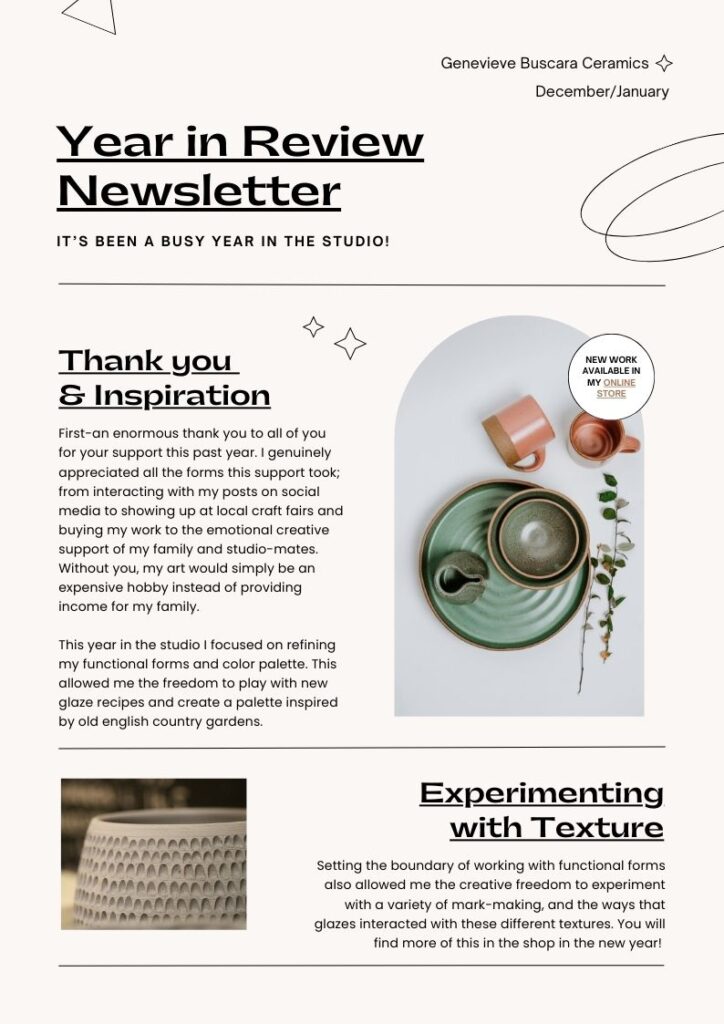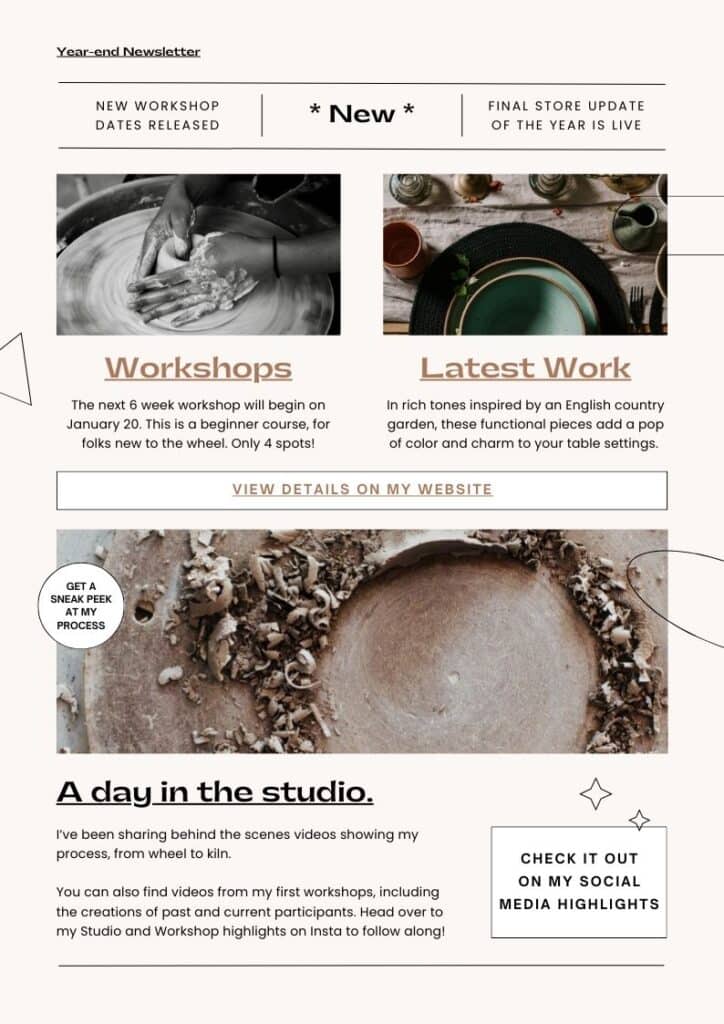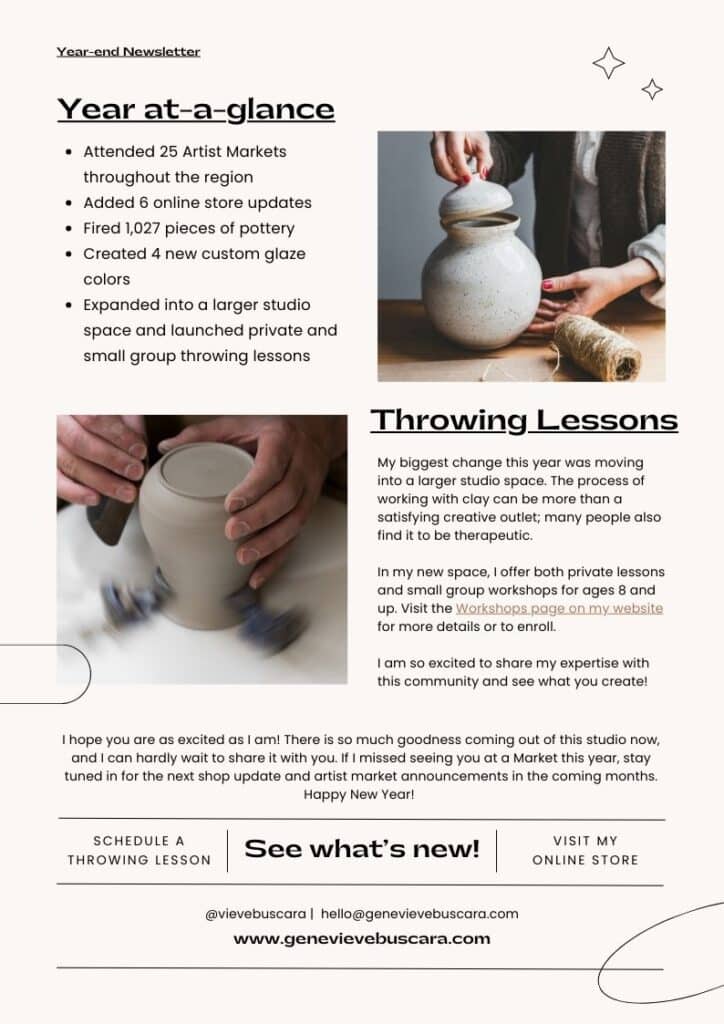Year end highlight emails are an effective way to communicate with your clients and mailing list–essentially, people who are invested in your creative ambitions about your growth this year. In fact, end of year highlight emails are probably one of the most underutilized and cost effective marketing tools available to creative professionals due to their higher than average engagement rates.
Throughout the year, client communication can take many different forms. Responding to prospective client inquiries, deploying feedback surveys, marketing special events or store updates, and sending personalized notes with an order are all examples of client communication. Your current and potential customers are part of your mailing list because they value the expertise and personal touch of an independent creative professional like you. Effective client communication, such as an end of year highlights email, has the power to reinforce your relationship with your patrons.
Effective Client Communication
When it comes to client communication, quality matters. People are exposed to communication from brands in their everyday lives, up to 50-400 ads a day through ads alone. Unlike ads, clients opt in to receiving communication from you, which means they want to hear from you.
So how can a creative professional break through the noise? Start with a little planning and foresight for the considerations below:
Setting out clear objectives
To begin, it’s important to give some thought to the strategy behind your message. If you had a busy year, it can be tempting to share all the information about everything you did. Instead, make a list of the work, exhibitions, or business announcements you want your followers to know about. Choose a few that are the most important or impactful and expand on those with a little more detail. Some items on your list could become links to see new work on your portfolio website, exhibitions with online galleries they can view, items in your online store, or other places where they can find more details on what interests them most.
Most importantly, think about what you’d like your followers to do most, if they only take one action on your email. Maybe that is to commission you for work, visit an upcoming exhibition or artist market, or purchase your artwork from your online store–whatever it is, make sure this primary goal is the most clear and grabs readers attention with a call to action (CTA).
Putting yourself into your audience’s shoes
A big part of making communication effective is to cater to the needs and wants of your audience. Some things to consider here are what information your audience may want to consume based on effective content you’ve shared in the past through email and social media, and reviewing what didn’t work so you can test different topics or email layouts. It can be challenging to view your own work from a neutral perspective–if you are having difficulty it may be useful for a colleague or a friend to review your draft and offer suggestions.
Crafting engaging, personalized messages
After you have created a blueprint for what you want to say, now it’s time to consider how you say it. The best messages are engaging and memorable. This is true when we reflect on the most timeless and memorable slogans. Consider Apple’s slogan: Think Different. Much like slogans, client communication is best when it is short, sweet, and to the point. Time is a precious commodity these days, and that extends to how much time it takes for a person to understand your message. Show your audience your respect for their time by taking time to edit and remove fluff from your writing.
Of course, being succinct doesn’t mean being boring. The tone and language used in your message should evoke the feelings you yourself have for the subject matter. Think about how you would explain it in conversation, include relevant adjectives and action verbs that get the audience as excited as you are about what you have to say, and then simplify or revise if it becomes too lengthy.
Selecting the right medium
You may have heard before that the medium is the message. Bringing this phrase by Canadian communication theorist Marshall McLuhan into the 20th century, it means that different communication platforms carry their own expectations and implications.
This is important for creative professionals because their audience’s expectations of the type of content shared vary based on how they have been conditioned to use these communications channels. Below are some example of different content expectations consumers have comment to expert by medium:
- Facebook: Interest-based and locally relevant content
- Instagram: Announcements, polished video content and lifestyle imagery
- Twitter: Hot off the press news in bite-sized format
- Email: Announcements, curated links, and receipts
- Blog: Mid-length content that speaks to the fan base
- Website: Announcements, releases, and blogs
While it might seem straightforward, placing your message in the wrong medium can lead to low viewership or worse, it can make your brand appear out-of-touch with modern communications practices.
Timing and frequency considerations
Just like being clear is a kindness you can offer the recipient of your communications, being mindful of timing is important. For example, product drops and limited-edition offers can be used strategically and announced by surprise. In contrast, events should be announced at least a week or two in advance to give people a time to prioritize it in their schedules.
Another way to approach timing is to leverage feedback in the form of simple data that many digital platforms provide the form of metrics. Views, open rates, dwell time, and click-throughs are some of the metrics creative professionals can use to learn what type of content performs best, as well as what time of day, day of the week yields the best results. Last but not least, frequency of communication should also be considered. Strike a balance between nothing and too much of a good thing–emailing too often can lead to followers unsubscribing if the recipient feels bombarded by your messages.
Crafting an End of Year Email
When it comes to composing and sending an end of year email, December or January are the ideal months. While you can also send an email mid-year, to mark a business anniversary, or to share or launch new work and upcoming exhibitions, these months are the best time to share year-end updates. This should typically include achievements you’d like to highlight, changes in your work or business, upcoming events, and to thank your followers for being part of your creative journey. It’s important to keep your end of year message simple and consider any actions you may want your audience to take when reading.
Purpose and benefits
What story do you want to tell people about your business? The purpose of an email is to observe an achievement and reflect on the fruits of your labor for the last 365 calendar days, in order to communicate one of the following messages to your audience:
- Remind people familiar with your brand that you exist
- Broaden people’s understanding of your abilities and skills
- Inspire people to book you for future projects
- Celebrate your growth with your fanbase
The purpose of the email could also be a compilation of the above, or your own objective. It’s important to identify why you want to send an end of year email so that the rest of the content you feature can coherently direct the recipient to your goal, especially the Call to Action (CTA) of the email.
Designing your email
Any communication that comes from you should look, sound, and feel like your brand. The same goes for emails. This can be achieved by using logos, fonts, colors, and image treatments (such as editing presets or filters) associated with your brand–essentially, tie them into these same elements on your website.
If you don’t use one already, it can be helpful to create a file with all this information in one place for easy reference. This can be as simple as a doc in your preferred cloud storage and should generally list the following:
- Your brand fonts for various headers and normal text.
- Hex codes for all colors, and clarification on which are primary and accent colors.
- Names of your favorite editing presets (if any)
- Tag lines or messaging you use often
- Links to folders where you store your logo files within a cloud-based storage solution, such as Google Drive, iCloud, Dropbox, etc.
- Your bio or cv, for easy access.
Consistency in your brand voice is a simple way to show your professionalism and make your communications easy to identify within the crowd of businesses vying for people’s attention. Refer to this file whenever you are designing something in a new place; many design programs will also allow you to save your brand colors and fonts, simplifying the process of creating newsletters and other branded graphics.
Approaching text
Try to keep paragraphs to 1-3 sentences each, using short sentences and easy-to-understand words. You can also use a variety of modules to create visual hierarchy and create flow in your email so it doesn’t feel too text-heavy.
For an overcap of the year, it makes sense to organize everything you want to cover into a list. You can include the list upfront to drum up anticipation, or go right into the items themselves.
Adding visual elements
If you think about emails you yourself don’t mind reading, they likely are visually-driven, with ample white space to allow the eye to rest. Think about applying the same principles to the email you send to your own mailing list.
Steer clear of using stock imagery, which can make people gloss over your email. Instead, include images of your work, a headshot, and/or behind the scenes or process images instead to add a personal touch.
Last but not least, bookend your email by starting and finishing with your logo, if you have one. The old marketing saying of, “you remember the first and last thing you read” tends to ring true for things you see, as well.
What does an end of year email look like?
This can vary depending on the type of creative professional you are, what step you want your followers to take next, and your audience. The items you wish to highlight can be very different if your audience is commercial vs. direct to consumer.
Below is an example of an end-of-year email from a ceramics artist.



As you can see, the artist focused on a few main components for the body of the email: new work in the store and their workshop opportunities. These ideas are repeated throughout the messaging, with slightly different information each time.
They also included a checklist of key achievements that are relevant to their business and followers, without overwhelming them with details on each item. Images of their work serve the dual purpose of breaking up the text and showing examples of their latest ceramics pieces available for purchase.
There are clear calls to action (CTAs) throughout, including links to pages on their website referenced in the text and social media profile. More on CTAs later.
Tailoring the Message for Different Professions
In the first few years of your mailing list, it’s important to lay a foundation relevant to your industry. For example, Artists, Designers, Illustrator, Photographers, Filmmakers, Fashion Designers, and Hair and Makeup Artists (HMUAs) will all tell their story a little differently. The more visual the medium, the more visuals mailing list recipients expect from the email, and vice versa. Creative professionals who work and sell directly to consumers will generally need to inject a little more of their personal voice and story into their communications, where those who work with galleries or commercial brands should have a more professional, straightforward approach.
When in doubt, consider developing a simple communications plan for the year that outlines the frequency and potential topics for your communications with your audience. This will help you stay ahead of schedule with messages to your audience, and when to announce important events and offers.
Highlighting Achievements
Think of your year-end email like a short exhibition of your creative output over the last year. Take some time to reflect on which of your experiences you want to celebrate, and why they feel significant. Some frequently used topics are:
- Showcasing new work or your progress in mastering a medium
- Telling a success story from your personal experience
- Receiving an award or a certification
- Sharing your point of view from behind the scenes
- Giving a glimpse of exciting future plans
In case you need some help getting started, we’ve gathered a few items to consider including in your year-end newsletter, organized by profession.
Artists
For artists who are creating work aimed at the general public (consumers), your year-end newsletter would be very similar to the ceramics artist example, and highlight topics such as:
- Artist markets and craft fairs you attended and sold your work at.
- Updates on the type of work you are currently offering, such as dates when new work will be available, where you found inspiration, or themes within your work.
- Changes in your art practice, big announcements, etc.
Artists who show and sell their work mainly through galleries could highlight:
- Listing past solo shows or group exhibitions in which you participated, including links out to the gallery’s exhibition overviews or page on your site with photographs from the show.
- Commissioned works you’d like to share or acknowledge.
- Upcoming exhibitions in the coming months.
- New themes or concepts you are exploring, with documentation of your work.
Designer/Illustrator
Designers and illustrators can take this opportunity to share some of their favorite commissioned or creative projects. This could include:
- Marketing products you’ve created, such as posters, brochures, or branding elements.
- Mock-ups and/or completed designs for architectural or interior spaces.
- Listing past and upcoming exhibitions or solo shows, including links for viewing or more information.
- Acknowledging or listing any awards you received, social features, and online or magazine interviews.
Photographers
Photographers creating mostly commercial work could highlight:
- Images and a brief summary from your shoots or campaigns with major brands and top clients.
- An overview of any personal or creative projects you’re ready to share.
- Links to updated portfolios including your recent work.
- Availability for upcoming projects or information on how to book your services.
When a photographer specializes in client work with the general public, such as headshots, weddings, and other portraiture, it is important to emphasize not only what sets your work apart, but the amazing client experience you offer. This might look like:
- Client testimonials that speak to your professionalism, consistency, and their positive experience working with you.
- A list of highlights that might include the number of sessions or events you shot this year, the top service and/or product package clients selected, how many images you edited, and any other important or engaging milestones.
- Images from some of your favorite shoots, with at least one behind the scenes shot or portrait of you.
- Information on your referral program, to remind your clients how they can be rewarded for spreading the word about you and your business
Fine art photographers in need of inspiration for their year-end newsletter can follow the recommendations for artists that work with galleries, as your audience will generally be very similar. Depending on whether you also offer workshops to other photographers, you might also add details on:
- Upcoming speaking engagements or workshops where other photographers can learn from you.
- A few details about one or two of your most used or helpful pieces of gear when out on a shoot.
Filmmakers
With the obvious skill overlap, and some filmmakers also offering photography services, it makes sense to pull ideas that resonate with you from the photography email newsletter topics. We also recommend including some of these suggestions:
- Include a brief teaser video for one or two of your most exciting film projects, with a link out to the longer video on your online portfolio website, or information on where your followers can find the full video.
- A few behind the scenes details relevant to your audience, such as people you worked with on a project, the gear used, or the thought process behind your creative decisions and why they made the film more visually appealing or engaging.
- Shout-outs to the rest of the creative team you worked with on some of your favorite projects, your regular crew, or a few key people that made a difference in your year.
- Highlight upcoming projects, or dates to look forward to for announcements of new film releases.
- Method for contact by people wanting to hire your services, with a link to the contact page on your website.
Fashion/HMUA (Hair and Makeup Artist)
Creative professionals in the fashion and beauty industry will need to consider their individual brand and audience so they strike the right balance between professional and personal. Here are some ideas to get you started:
- Professional images of fully styled models or celebrities, highlighting your work.
- Behind the scenes photos or videos with parts of your creative process
- Before/after for HMU work, to showcase the difference
- A list highlighting some notable brands, models, or celebrities you worked with, magazines or online brands where you were featured, and the names of collections you released this year.
- The availability of your designs or branded products in your online store, or a date for the next release, and a link to your store.
For HMUA who work primarily with the general public rather than editorial or fashion industry professionals, you should also include some client-experience details, such as:
- The number of bridal or pre-photoshoot clients you had this year.
- Client testimonials about the experience of working with you.
- Links to your online portfolio, updated with some of your most recent client work.
- Your availability–if your calendar is already filling up, now is the time to let your followers know this–and how to book your services!
Once you have a list of possible options, try to look for a common thread that could help give your email structure or a unifying theme. If you get stuck, think about it from the perspective of your mailing list community and ask yourself, “What kind of emails do I enjoy reading from my favorite creative individuals or collectives?”
Call to Action
It’s important to remember that most emails are meant to serve as pathways to other destinations, such as your online portfolio and social media accounts. When the reader opens your email, they have an implicit understanding that the email is meant to entice them to click somewhere to see or get access to something. The Call to Action (CTA) text serves as an invitation, clearly communicating what action you want your audience to take.
Most CTAs use an action verb and keep it under 5 words. Some common ones are:
- Reserve your spot
- Get instant access
- Join the community
- Browse my collection
- Request a consultation
- Read our story
- Shop new arrivals
- Start your adventure
- Get your custom quote
- Browse by medium
- Get in touch
- Take me there
Different CTAs work best depending on the email objective and audience. When in doubt, refer to the list above to find the right CTA phrasing for your year-end email, and customize to fit your brand.
Don’t Overthink; Send the Email
Before you talk yourself out of sending a year-end email, not wanting to contribute to the “noise” during this busy time of year, it is important to remember that your audience has consented to receive your messages. This means that they signed up to be a part of your mailing list because they like hearing from creative people like you. In this way, you are already ahead of most other marketing mediums out there–the audience you have is captive.
Giving client communication the attention it deserves benefits everyone: your audience who wants to hear about your work, and your business. Email newsletters from independent creators are important because they help bring visibility to your efforts and give you a chance to pause and reflect on your accomplishments.
Writing Effective Year-end Emails Is Not Rocket Science
As you curate the structure and content of your year-end email newsletter, remember the following considerations:
- Identify your audience and your purpose for sending them the email
- Keep your messages short and to the point
- Include relevant images to break up the text and add visual interest
- Customize the content to your personal brand and industry
- Pique their interest with engaging text and a strong CTA
When it comes to your business, you are the subject matter expert. There is no wrong way to write a year end email, as long as you approach this with the level of thoughtfulness that you bring to your creative work.









